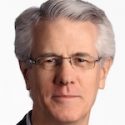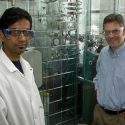Wisconsin Institutes for Discovery facility opens on UW-Madison campus
Twin research institutes and a space designed for all to engage in science opened Thursday (Dec. 2) on the University of Wisconsin–Madison campus.
The mission shared by the three partners in the new facility, intended to become a destination in Madison for attracting researchers, students, businesses and visitors from across the state and around the world, is to accelerate the creation of knowledge to advance human health and well-being.
In addition to Thursday’s grand opening ceremony, events run through Dec. 11 to celebrate the completion of the Wisconsin Institutes for Discovery building, an innovative public-private building project that began three years ago.
Within the building, UW–Madison’s public Wisconsin Institute for Discovery and the private Morgridge Institute for Research work to address critical challenges in fields ranging from virology and medical devices to the design of living spaces that accommodate home health care needs. World-class scientists leading the institutes include James Thomson, who was the first to isolate and grow human embryonic stem cells in 1998 and reprogrammed adult skins cells to a pluripotent state in 2007. Thomson serves as director of regenerative biology at the Morgridge Institute for Research.
In addition to the public and private institutes, the Town Center spans the main floor and includes three embedded teaching labs for educational outreach on the upper floors. The Town Center welcomes scientists and the public to inspire learners of all ages, showcase research and accelerate the movement of scientific discoveries from the lab to marketplace. Food venues in the Town Center will serve campus and community members and cater to major scientific, business and cultural gatherings.
The Thursday afternoon grand opening ceremony featured a keynote address by Bruce Alberts, editor-in-chief of the journal Science, along with remarks from Wisconsin Gov. Jim Doyle; UW–Madison Chancellor Biddy Martin; John and Tashia Morgridge, donors and UW–Madison alumni; Ernest Micek, a trustee with the Wisconsin Alumni Research Foundation (WARF); and Carl Gulbrandsen, managing director of WARF. Former UW–Madison Chancellor John Wiley, interim director of the Wisconsin Institute for Discovery, and Sangtae “Sang” Kim, executive director of the Morgridge Institute for Research, introduced the scientists who will lead the research efforts.
Construction of the 300,000-square-foot building was made possible through a combination of support from UW–Madison, the state of Wisconsin, private donors John and Tashia Morgridge and WARF. WARF serves as the operations manager and owns the eastern 70 percent of the land and building while the university owns the western 30 percent in a condominium that covers an entire city block.
The five-story building, built to use 50 percent less energy and water than a typical lab building on campus, includes laboratories and space designed for researchers on the upper three floors and the lower level. The labs have been designed to be flexible and adaptable for different types of science with the goal of serving research needs for 100 years. The construction cost for the facility totaled $150 million with an additional $60 million funding the laboratory fit-outs, equipment and support. It is the first research facility on the UW–Madison campus designed to achieve LEED silver certification for green building practices.
“The institutes were created to make the UW–Madison even more competitive than it is. Putting a private research institute next to a public research institute allows the public side to leverage the flexibility and nimbleness of the private side and the private side to take advantage of the impressive infrastructure and human capital available at UW–Madison,” said WARF’s Gulbrandsen. “The work of the institutes is intended to reach out across the university and the globe. The goal is not to privatize the university but to make a great public university an even greater public university.”
UW-Madison Chancellor Biddy Martin praised the project for sparking creativity and collaboration from its earliest days.
“When John and Tashia Morgridge and Gov. Jim Doyle set out to create private and publicly funded labs under one roof, it was with the hope that the right atmosphere would attract fresh perspectives and speed discoveries in key scientific fields,” Martin said. “Already, it appears that the public Wisconsin Institute for Discovery and the private Morgridge Institute for Research are progressing toward this vision and inspiring new connections across campus, throughout our state and around the world.”
The project also is expected to produce a beneficial economic impact on the state of Wisconsin as a full complement of scientists and support staff members are hired and compete successfully for additional research funding. Total employment in the Wisconsin Institutes for Discovery building is expected to reach 350.
The Wisconsin Institute for Discovery is led by former UW–Madison Chancellor John Wiley, who serves as interim director; the Morgridge Institute for Research is led by Sangtae “Sang” Kim, who serves as executive director and leader of the pharmaceutical informatics challenge area.
Following are the key research themes, challenge areas and scientists who lead the work in both institutes; all will be moving into the new facility over the next two months:
Wisconsin Institute for Discovery
- Epigenetics focuses on how genes are activated or inactivated and is led by John M. Denu, professor of biomolecular chemistry in UW–Madison’s School of Medicine and Public Health.
- BIONATES, which focuses on tissue engineering scaffold research, is led by Lih-Sheng “Tom” Turng, UW–Madison professor of mechanical engineering.
- Health technology design in the Living Environments Laboratory aims to accelerate the development of personal care diagnostic and therapeutic technology and is led by Patricia Flatley Brennan, professor of both engineering and nursing at the university.
- Optimization is a mathematical approach to minimize or maximize the variables in complex questions, and is led by Michael C. Ferris, UW–Madison professor of computer science.
- Systems Biology, led by by John Yin, UW–Madison professor of chemical and biological engineering, strives to provide an integrated understanding of how the cells and tissues and parts of organisms interact with each other and scale up into the interactions of large populations of living things.
Morgridge Institute for Research
- Regenerative Biology is led by scientific director James Thomson, also a professor at UW–Madison’s School of Medicine and Public Health, whose current work focuses on understanding how a cell maintains or changes identity. The work may lead to knowledge that helps prevent and treat degenerative diseases and aid in the development of drugs tailored to specific needs.
- Virology is headed by principal investigator Paul Ahlquist, a UW–Madison oncology professor and Howard Hughes Medical Investigator. Ahlquist and other investigators are focusing on discoveries to better understand, prevent and treat diseases caused by viruses, including hepatitis C, cancer, AIDS and influenza.
- Medical Devices is led by scientific director Thomas “Rock” Mackie, a medical physics professor with UW–Madison’s School of Medicine and Public Health. Mackie and other investigators are seeking to understand how certain health conditions can be helped by medical devices and how to better invent, build and test these devices and improve the regulatory approval process to benefit more patients.
- Pharmaceutical Informatics is led by executive director Sang Kim, who previously held professorships in engineering at UW–Madison and Purdue University as well as senior leadership roles in industry and at the National Science Foundation. His scientific work includes expanding the library of known chemical compounds through superfast and immense scale computing.
- Outreach Experiences is led by scientific director Nirupama “Rupa” Shevde, also a senior scientist with the WiCell Research Institute. Shevde’s group develops and presents programs and resources to promote education and discovery in regenerative biology, virology and medical devices.
Supporting Both Institutes
- Education Research is led by scientific director Susan Millar, a senior scientist with the Wisconsin Center for Education Research. The group develops online interactive computer games and other resources to help youth and adults learn about core science, biomedical and health management concepts.
- Core Computational Technology is led by scientific director Miron Livny, a UW–Madison computer science professor. His work provides the advanced computing tools and infrastructure needed by scientists in both institutes.
The Morgridges, loyal UW–Madison alumni who now serve as trustees of the Morgridge Institute, said they were pleased to see the impact of their $50 million gift magnified thanks to the involvement of the university, the state of Wisconsin and WARF.
“Already, the paths of the 12 scientists affiliated with the two institutes have crossed, sparking meaningful collaborations in virology and systems biology, medical devices and tissue engineering,” said John Morgridge, chairman emeritus of Cisco Systems.
“We also are seeing promising results from our education and outreach efforts-some of which started before construction on the Wisconsin Institutes building began,” said Tashia Morgridge, a retired special education teacher. “These efforts have already reached more than 2,000 students and learners of all ages with programs designed to build self-confidence and scientific skills. Now that the doors are open, we will expand efforts to inspire the next generation of scientists and welcome all who wish to gather and explore the opportunities science provides for better health and better living.”



